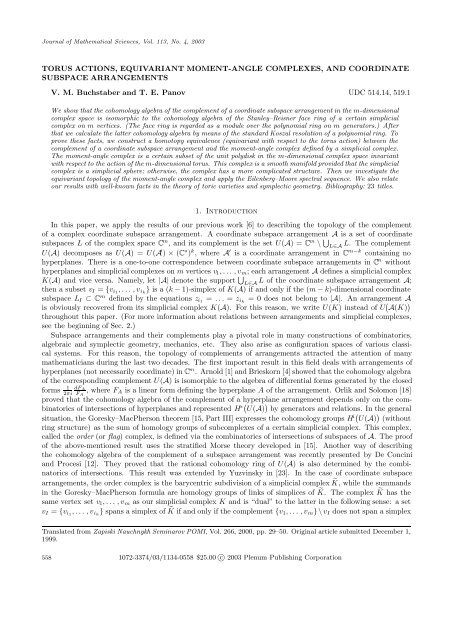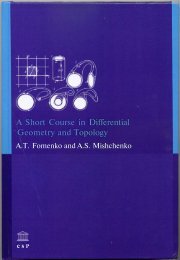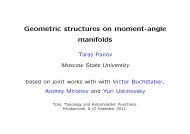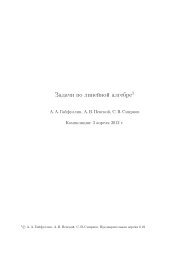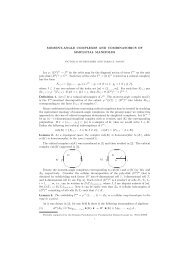pdf (English) - Geometry and Topology (Russian)
pdf (English) - Geometry and Topology (Russian)
pdf (English) - Geometry and Topology (Russian)
Create successful ePaper yourself
Turn your PDF publications into a flip-book with our unique Google optimized e-Paper software.
subspace arrangement A contains a hyperplane z i = 0, then its complement U(A) is represented as U(A 0 ) × C ∗ ,where A 0 is a coordinate subspace arrangement in the hyperplane {z i =0}<strong>and</strong> C ∗ = C \{0}. Thus, for anycoordinate subspace arrangement A, the complement U(A) decomposes asU(A) =U(A ′ )×(C ∗ ) k ,where A ′ is a coordinate arrangement in C m−k containing no hyperplanes. Keeping this in mind, we restrictourselves to coordinate subspace arrangements without hyperplanes.A coordinate subspace arrangement A in C m (without hyperplanes) defines a simplicial complex K(A) withm vertices v 1 ,...,v m in the following way: we say that a subset v I = {v i1 ,...,v ik }is a (k − 1)-simplex of K(A)if <strong>and</strong> only if L I ⊄ |A|.Example 2.2. 1. If A = ∅, then K(A) is the (m − 1)-dimensional simplex ∆ m−1 .2. If A = {0}, then K(A) =∂∆ m−1 is the boundary of an (m − 1)-simplex.On the other h<strong>and</strong>, a simplicial complex K on the vertex set {v 1 ,...,v m }defines an arrangement A(K) suchthat L I ⊂ |A| if <strong>and</strong> only if v I = {v i1 ,...,v ik } is not a simplex of K. Note that if K ′ ⊂ K is a subcomplex,then A(K) ⊂A(K ′ ). Thus, we have a reversing order one-to-one correspondence between simplicial complexeson m vertices <strong>and</strong> coordinate subspace arrangements in C m without hyperplanes.Let U(K) =C m \|A(K)|denote the complement of a coordinate subspace arrangement A(K).Example 2.3. 1. If K =∆ m−1 is the (m − 1)-simplex, then U(K) =C m .2. If K = ∂∆ m−1 , then U(K) =C m \{0}.3. If K is a disjoint union of m vertices, then U(K) is obtained by removing from C m all coordinate subspacesz i = z j =0,i,j=1,...,m, of codimension 2.Let k be a field. Below we call this field the ground field. Consider a polynomial ring k[v 1 ,...,v m ], wherethe v i are regarded as variables.Definition 2.4. The face ring (the Stanley–Reisner ring) k(K) of the simplicial complex K is the quotient ringk[v 1 ,...,v m ]/I, whereI = { v i1 ···v is : {v i1 ,...,v is } does not span a simplex in K } .Thus, the face ring is a quotient ring of the polynomial ring by the ideal generated by square-free monomialsof degree 2. We make k(K) a graded ring, setting deg v i =2,i=1,...,m.Example 2.5. 1. If K =∆ m−1 , then k(K) =k[v 1 ,...,v m ].2. If K = ∂∆ m−1 is the boundary complex of an (m − 1)-simplex, thenk(K) =k[v 1 ,...,v m ]/(v 1···v m ).A compact torus T m acts on C m diagonally. Since the arrangement A(K) consists of coordinate subspaces,this action is also defined on U(K). Denote by B T K the corresponding Borel construction,B T K = ET m × T m U(K), (1)where ET m is the contractible space of the universal T m -bundle ET m → BT m over the classifying spaceBT m =(CP ∞ ) m . Thus, B T K is the total space of the bundle B T K → BT m with fiber U(K).The space BT m has a canonical cellular decomposition (i.e., each CP ∞ has one cell in each even dimension).For any index set I = {i 1 ,...,i k }, one may consider the cellular subcomplex BTIk = BTk i 1,... ,i k⊂ BT mhomeomorphic to BT k .Definition 2.6. Given a simplicial complex K with vertex set {v 1 ,...,v m }, define the cellular subcomplex˜B T K ⊂ BT m as the union of the subcomplexes BTI k over all I such that v I is a simplex of K.Example 2.7. Let K be a disjoint union of m vertices v 1 ,...,v m . Then ˜B T K is a bouquet of m copies ofCP ∞ .The cohomology ring of BT m is isomorphic to the polynomial ring k[v 1 ,...,v m ] (all cohomologies are withcoefficients in the ground field k).560
Lemma 2.8. The cohomology ring of ˜B T K is isomorphic to the face ring k(K). The embedding i : ˜B T K↩→BT m induces the quotient epimorphism i ∗ : k[v 1 ,...,v m ]→k(K)=k[v 1 ,...,v m ]/I in the cohomology.Proof. The proof is by induction on the number of simplices of K. IfKis a disjoint union of vertices v 1 ,...,v m ,then ˜B T K is a bouquet of m copies of CP ∞ (see Example 2.7). In degree zero, H ∗ ( ˜B T K) coincides with k, whilein degrees 1, this ring is isomorphic to k[v 1 ] ⊕···⊕k[v m ]. Therefore, H ∗ ( ˜B T K)=k[v 1 ,...,v m ]/I, where I isthe ideal generated by all square-free monomials of degree 2, <strong>and</strong> i ∗ is the projection onto the quotient ring.Thus, the lemma holds for dim K =0.Now assume that the simplicial complex K is obtained from a simplicial complex K ′ by adding one (k − 1)-dimensional simplex v I = {v i1 ,...,v ik }. By the induction hypothesis, the lemma holds for K ′ , i.e., i ∗ H ∗ (BT m )=H ∗ (˜B T K ′ )=k(K ′ )=k[v 1 ,...,v m ]/I ′ . By Definition 2.6, ˜B T K is obtained from ˜B T K ′ by adding the subcomplexBTi k1,... ,i k⊂ BT m . Then H ∗ (˜B T K ′ ∪ BTi k1,... ,i k)=k[v 1 ,...,v m ]/I = k(K ′ ∪ v I ), where I is generated byI ′ <strong>and</strong> v i1 v i2 ···v ik .□Let I m be the st<strong>and</strong>ard m-dimensional cube in R m :I m = {(y 1 ,...,y m )∈R m : 0 y i 1,i=1,...,m}.A simplicial complex K with m vertices v 1 ,...,v m defines a cubical complex C K embedded canonically into theboundary complex of I m in the following way.Definition 2.9. For any (k − 1)-dimensional simplex v J = {v j1 ,...,v jk } of K, denote by C J the k-dimensionalface of I m defined by the following m − k equations:y i =1, i /∈{j 1 ,...,j k }.We define a cubical subcomplex C K ⊂ I m as the union of the faces C J over all simplices v J of K.Remark. Our cubical subcomplex C K ⊂ I m is a geometric realization of an abstract cubical complex in the coneover the barycentric subdivision of K (see [11, p. 434]). Indeed, let ∆ m−1 be an (m − 1)-dimensional simplexon the vertex set {v 1 ,...,v m } <strong>and</strong> let ̂∆ m−1 be the barycentric subdivision of ∆ m−1 , i.e., ̂∆ m−1 has a vertexcorresponding to each simplex v J of ∆ m−1 . Construct a map ι : ̂∆ m−1 → I m taking a vertex v J of ̂∆ m−1 tothe vertex of I m having the coordinates y j = 0 for j ∈ J <strong>and</strong> y j = 1 for j /∈ J. Extend this map linearly toeach simplex of ̂∆ m−1 . The image of ̂∆ m−1 under the constructed map is the union of faces of I m meeting atzero. Now we construct a map Cι from the cone Ĉ∆ m−1 over ̂∆ m−1 to I m taking the vertex of the cone tothe vertex (1,...,1) of the cube. Extend the latter map linearly to simplices of Ĉ∆ m−1 . The image of C ̂∆ m−1under the map Cι is the whole cube I m . Now let K be a simplicial complex on the vertex set {v 1 ,...,v m }.Once a numeration of vertices is fixed, we may consider K as a simplicial subcomplex of ∆ m−1 . Then ourcubical complex C K ⊂ I m from Definition 2.9 coincides with the image Cι(C ̂K) of the cone over the barycentricsubdivision of K under the map Cι.Example 2.10. Figures 1a <strong>and</strong> 1b represent a cubical complex C K in the cases where K is a disjoint union of3 vertices or the boundary complex of a 2-simplex, respectively.Fig. 1. The cubical complex C K .561
Remark. In the case where K is the dual to the boundary complex of an n-dimensional simple polytope P n ,the cubical complex C K coincides with the cubical subdivision of P n studied in [6].The orbit space of the diagonal action of T m on C m is the positive coneR m + = {(y 1,...,y m )∈R m : y i 0,i=1,...,m}.The orbit map C m → R m + is determined by (z 1 ,...,z m ) →(|z 1 | 2 ,...,|z m | 2 ). If we restrict the above action tothe st<strong>and</strong>ard polydisk(D 2 ) m = {(z 1 ,...,z m )∈C m : |z i |1,i=1,...,m}⊂C m ,then the corresponding orbit space is the st<strong>and</strong>ard cube I m ⊂ R m + .Let U R (K) ⊂ R m + denote the orbit space U(K)/T m . Note that if we consider R m + as a subset in C m , thenU R (K) is the corresponding “real part”: U R (K) =U(K)∩R m +.Definition 2.11. The equivariant moment-angle complex Z K ⊂ C m corresponding to a simplicial complex Kis defined to be the T m -space determined by the commutative diagramZ K⏐↓−−−−→ (D 2 ) m⏐↓C K −−−−→ I m ,where the right-h<strong>and</strong> vertical arrow denotes the orbit map for the diagonal action of T m <strong>and</strong> the lower horizontalarrow denotes the embedding of the cubical complex C K into I m .Lemma 2.12. We have the inclusions C K ⊂ U R (K) <strong>and</strong> Z K ⊂ U(K).Proof. Definition 2.11 shows that the second inclusion follows from the first one. To prove the first inclusion, wenote that if a point a =(y 1 ,...,y m )∈C K has the coordinates y i1 = ...=y ik = 0, then v I = {v i1 ,...,v ik } is asimplex of K, hence L I ⊄ A(K).□Lemma 2.13. The complement U(K) is equivariantly homotopy equivalent to the moment-angle complex Z K .Proof. We construct a retraction r : U R (K) →C K which is covered by an equivariant retraction U(K) →Z K .The latter retraction is the required homotopy equivalence.The retraction r : U R (K) →C K is constructed inductively. We start with the boundary complex of an(m − 1)-simplex <strong>and</strong> remove simplices of positive dimensions until we obtain K. At each step, we construct aretraction. The composite map gives us the required retraction r. If K = ∂∆ m−1 is the boundary complex ofan (m − 1)-simplex, then U R (K) =R m + \{0}, <strong>and</strong> the retraction r is shown in Fig. 2.Fig. 2. The retraction r : U R (K) →C K for K = ∂∆ m−1 .Assume that the simplicial complex K is obtained by removing one (k − 1)-dimensional simplex v J ={v j1 ,...,v jk }from a simplicial complex K ′ . By the induction hypothesis, the lemma holds for K ′ , i.e., there is aretraction r ′ : U R (K ′ ) →C K ′ with the required properties. Let us consider the face C J ⊂ I m (see Definition 2.9).Since v J is not a simplex of K, the point a with the coordinates y j1 = ... = y jk =0,y i =1,i/∈{j 1 ,...,j k },562
does not belong to U(K). Hence, we may apply the retraction from Fig. 2 on the face C J , starting from thepoint a. Denote this retraction by r J . Now we take r = r J ◦ r ′ . It is easy to see that r is exactly the requiredretraction.□Example 2.14. 1. If K = ∂∆ m−1 is the boundary complex of an (m − 1)-simplex, then Z K is homeomorphicto the (2m − 1)-dimensional sphere S 2m−1 .2. If K is the dual to the boundary complex of an n-dimensional simple polytope P n , then Z K is homeomorphicto a smooth (m + n)-dimensional manifold. This manifold, denoted Z P , is the main object of study in [6].Corollary 2.15. The Borel construction ET m × T m Z K is homotopically equivalent to B T K.Proof. The retraction r : U(K) →Z K constructed in the proof of Lemma 2.13 is equivariant with respect to theT m -actions on U(K) <strong>and</strong> Z K . The equality B T K = ET m × T m U(K) proves our corollary.□In what follows, we do not distinguish the Borel constructions ET m × T m Z K <strong>and</strong> B T K = ET m × T m U(K).Theorem 2.16. The cellular embedding i : ˜B T K↩→BT m (see Definition 2.6) <strong>and</strong> the fibration p : B T K →BT m (see (1)) are homotopically equivalent. In particular, ˜B T K <strong>and</strong> B T K are of the same homotopy type.Proof. Let π : Z K →C K denote the orbit map for the torus action on the moment-angle complex Z K (seeDefinition 2.11). For any subset I = {i 1 ,...,i k } ⊂ {1,...,m}, denote by B I the following subset of thepolydisk (D 2 ) m : B I = B 1 ×···×B m ⊂D 2 ×···×D 2 =(D 2 ) m , where B i is the disk D 2 if i ∈ I <strong>and</strong> B i is theboundary S 1 of D 2 if i/∈I. Thus, B I∼ = (D 2 ) k × T m−k , where k = |I|. It is easy to see that if C I is a face of thecubical complex C K (see Definition 2.9), then π −1 (C I )=B I . Since B I is canonically identified with a subset ofB J for I ⊂ J, we see that the subsets B I such that v I is a simplex of K fit together to compose Z K . (This ideacan be used to prove that Z K is a smooth manifold provided that K is the dual to the boundary complex of asimple polytope; see [6, Theorem 2.4].)For any simplex v I ⊂ K, the subset B I ⊂Z K is invariant with respect to the T m -action on Z K . Hence, theBorel construction B T K = ET m × T m Z K is glued from the Borel constructions ET m × T m B I (cf. the localconstruction of B T P of [11, p. 435]). The latter space can be factorized as ET m × T m B I = ( ET k × T k (D 2 ) k) ×ET m−n , which is homotopically equivalent to BTI k. Hence, the restriction of the projection p : B T K → BT m toET m × T m B I is homotopically equivalent to the embedding BTIk ↩→ BT m . These homotopy equivalences for all ofthe simplices v I ⊂ K are glued together to give us the required homotopy equivalence between p : B T K → BT m<strong>and</strong> i : ˜B T K↩→BT m .□Corollary 2.17. The complement U(K) of a coordinate subspace arrangement is a homotopy fiber of thecellular embedding i : ˜B T K↩→BT m .( )Corollary 2.18. The T m -equivariant cohomology ring HT ∗ U(K) is isomorphic to the face ring k(K).m( )Proof. We have the equalities H ( T ∗ U(K) = H∗ET m × m T m U(K) ) = H ∗ (B T K), hence the corollary followsfrom Lemma 2.8 <strong>and</strong> Theorem 2.16.□3. Cohomology ring of U(K)Consider a k[v 1 ,...,v m ]-free resolution of the face ring k(K) as a graded module over the polynomial ringk[v 1 ,...,v m ]:0 → R −h d −h−−−−→ R −h+1d −h+1−−−−→ ···→R −1d−−−−→ −1R 0 d−−−−→ 0k(K ) → 0 (2)(note that the Hilbert syzygy theorem implies that h m in (2)). Applying the functor ⊗ k[v1,... ,v m]k to (2), weobtain the following cochain complex:0 −→ R −h ⊗ k[v1,... ,v m] k −→···−→R 0 ⊗ k[v1,... ,v m] k −→ 0.Its cohomology modules are denoted by Tor −i)k[v 1,... ,v m]( k(K), k . Since all of the R −i in (2) are graded k[v 1 ,...,v m ]-modules,Tor −ik[v 1,... ,v m](k(K), k)=⊕jTor −i,j ( )k[v 1,... ,v m] k(K), k563
is a graded k-module, <strong>and</strong>Tor k[v1,... ,v m](k(K), k)=⊕i,jTor −i,j ( )k[v 1,... ,v m] k(K), kis a bigraded k-module. Note that nonzero elements of the latter module have nonpositive first grading <strong>and</strong>nonnegative even second grading (since deg v i =2). The bigraded k-module (3) can also be regarded as a onegradedmodule with respect to the total degree −i + j. The Betti numbersβ −i( k(K) ) = dim k Tor −i ( )k[v 1,... ,v m] k(K), k<strong>and</strong>β −i,2j( k(K) ) = dim k Tor −i,2j ( )k[v 1,... ,v m] k(K), kare of great interest in geometric combinatorics; these numbers were studied by various authors (see, for example,[22]). We mention only one theorem due to Hochster, which reduces the calculation of β −i,2j( k(K) ) tocalculating the homology of subcomplexes of K.Theorem 3.1 (Hochster [16, 22]). The Hilbert series∑β −i,2j (k(K))t 2jof Tor −ik[v 1,...,v m](k(K), k) can be calculated as follows:∑β −i,2j( k(K) ) ∑t 2j =jjI⊂{v 1,... ,v m}(dimk ˜H |I|−i−1 (K I ) ) t 2|I| ,where K I is the subcomplex of K consisting of all simplices with vertices in I.Note that the calculation of β −i,2j( k(K) ) using this theorem is very complicated even for small K.)It turns out that Tor k[v1,... ,v m]( k(K), k is a bigraded algebra in a natural way, <strong>and</strong> the associated one-gradedalgebra is exactly H ∗( U(K) ) .Theorem 3.2. The following isomorphism of graded algebras holds:H ∗( U(K) ) ∼ = Tork[v1,... ,v m](k(K), k).Proof. Let us consider the commutative diagramŨ(K) −−−−→ ET m⏐⏐↓↓˜B T Ki−−−−→ BT m ,(4)where the left-h<strong>and</strong> vertical arrow is the induced fiber bundle. Corollary 2.17 shows that Ũ(K) is homotopicallyequivalent to U(K).From (4) we deduce that the cellular cochain algebras C ∗ ( ˜B T K) <strong>and</strong> C ∗ (ET m ) are modules over C ∗ (BT m ). Itis clear from the proof of Lemma 2.8 that C ∗ ( ˜B T K)=k(K) <strong>and</strong> that i ∗ : C ∗ (BT m )=k[v 1 ,...,v m ]→k(K)=C ∗ (˜B T K) is the quotient epimorphism. Since ET m is contractible, we have a chain equivalence C ∗ (ET m ) → k.Therefore, there is an isomorphismTor C ∗(BT m )( C ∗ ( ˜B T K),C ∗ (ET m ) ) ∼ = Tork[v1,... ,v m]( k(K), k) . (5)The Eilenberg–Moore spectral sequence (see [21, Theorem 1.2]) of commutative square (4) has the E 2 -term,E 2 =Tor H∗ (BT m )(H ∗ ( ˜B T K),H ∗ (ET m ) ) ,564
<strong>and</strong> converges to Tor C∗ (BT m )(C ∗ ( ˜B T K),C ∗ (ET m )). SinceTor H ∗ (BT m )(H ∗ ( ˜B T K),H ∗ (ET m ))=Tor k[v1,... ,v m](k(K), k),it follows from (5) that the spectral sequence collapses at the E 2 term, i.e., E 2 = E ∞ . Proposition 3.2 of [21] showsthat the module Tor C∗ (BT )( m C ∗ ( ˜B T K),C ∗ (ET m ) ) is an algebra isomorphic to H ∗( Ũ(K) ) , which concludes theproof.□Our next theorem gives us an explicit description of the algebra H ∗( U(K) ) as the cohomology algebra ofa simple differential bigraded algebra. We consider the tensor product k(K) ⊗ Λ[u 1 ,...,u m ] of the face ringk(K) =k[v 1 ,...,v m ]/I <strong>and</strong> an exterior algebra Λ[u 1 ,...,u m ]onmgenerators. We make this tensor product adifferential bigraded algebra by settingbideg v i =(0,2), bideg u i =(−1,2), d(1 ⊗ u i )=v i ⊗1, d(v i ⊗1)=0, (6)<strong>and</strong> requiring that d is a derivation of algebras.Theorem 3.3. The following isomorphism of graded algebras holds:H ∗( U(K) ) ∼ = H[ k(K) ⊗ Λ[u1 ,...,u m ],d ] ,where the right-h<strong>and</strong> side is the one-graded algebra associated with the bigraded cohomology algebra.Proof. One can make k a k[v 1 ,...,v m ]-module by applying the homomorphism mapping 1 to 1 <strong>and</strong> v i to0. Let us consider the Koszul resolution (see, for example, [17, Chapter VII, Section 2]) of k regarded as ak[v 1 ,...,v m ]-module: [k[v1 ,...,v m ]⊗Λ[u 1 ,...,u m ],d ] ,where the differential d is defined similarly to (6).Since the bigraded torsion product Tor k[v1,... ,v m]( , ) is a symmetric function of its arguments, one has theequalitiesTor Γ( k(K), k) = H[ k(K) ⊗Γ Γ ⊗ Λ[u 1 ,...,u n ],d ] = [ Γ⊗Λ[u 1 ,...,u m ],d ] ,where we denoted Γ = k[v 1 ,...,v m ]. Since H ∗( U(K) ) ( )∼ = TorΓ k(K), k by Theorem 3.2, we obtain the requiredisomorphism.□Note that the above-formulated theorem not only calculates the cohomology algebra of U(K) but also makesthis algebra bigraded.Corollary 3.4. The Leray–Serre spectral sequence of the bundleŨ(K) → ˜B T K with fiber T m (see (4)) collapsesat the E 3 term.Proof. The spectral sequence under consideration converges to H ∗( Ũ(K) ) = H ∗( U(K) ) , <strong>and</strong> the followingequalities hold:E 2 = H ∗ ( ˜B T K) ⊗ H ∗ (T m )=k(K)⊗Λ[u 1 ,...,u m ].It is easy to see that the differential in the E 2 term acts similarly to (6). Hence, E 3 = H[E 2 ,d]=H [ k(K)⊗Λ[u 1 ,...,u m ] ] =H ∗( U(K) ) by Theorem 3.3.□Proposition 3.5. Assume that a monomialv α1i 1...v αpi pu j1 ...u jq ∈k(K)⊗Λ[u 1 ,...,u m ],where i 1 < ...
homotopy equivalence can be treated as the orbit map U(K) → U(K)/R m−n ∼ = Z K with respect to a certainaction of R m−n on U(K).The coordinate subspace arrangement A(K) <strong>and</strong> its complement U(K) play an important role in the theory oftoric varieties <strong>and</strong> symplectic geometry (see, for example, [2, 3, 9]). More precisely, any n-dimensional simplicialtoric variety M defined by a (simplicial) fan Σ in Z n with m one-dimensional cones can be obtained as thegeometric quotient U(K Σ )/G. Here G is a subgroup of the complex torus (C ∗ ) m isomorphic to (C ∗ ) m−n <strong>and</strong>K Σ is the simplicial complex defined by the fan Σ (i-simplices of K Σ correspond to (i + 1)-dimensional cones ofΣ). A smooth projective toric variety M is a symplectic manifold of real dimension 2n. This manifold can beconstructed by the process of symplectic reduction in the following way. Let G R∼ = T m−n denote the maximalcompact subgroup of G <strong>and</strong> let µ : C m → R m−n be the moment map for the Hamiltonian action of G R on C m .Then, for each regular value a ∈ R m−n of µ, there is a diffeomorphismµ −1 (a)/G R −→ U (K Σ )/G = M(see [9] for more information). In this situation, it can be seen easily that µ −1 (a) is exactly our manifold Z Kfor K = K Σ .Example 3.6. Let G ∼ = C ∗ be the diagonal subgroup in (C ∗ ) n+1 <strong>and</strong> let K Σ be the boundary complex of an n-simplex. Then U(K Σ )=C n+1 \{0}, <strong>and</strong> M = C n+1 \{0}/C ∗ is the complex projective space CP n . The momentmap µ : C m → R takes (z 1 ,...,z m )∈C m to 1 2 (|z 1| 2 + ...+|z m | 2 ), <strong>and</strong> for a ≠ 0, one has µ −1 (a) ∼ = S 2n+1 ∼ = Z K(see Example 2.14).If K is a simplicial sphere (hence, the complement U(K) is homotopically equivalent to the smooth manifoldZ K ), then there is a Poincaré duality defined in the cohomology ring of U(K).Proposition 3.7. Assume that K is a simplicial sphere of dimension n − 1, hence U(K) is homotopicallyequivalent to the smooth manifold Z K . Then the following statements hold.(1) The Poincaré duality in H ∗( U(K) ) respects the bigraded structure defined by Theorem 3.3. More precisely,if α ∈ H −i,2j (U(K) ) is a cohomology class, then its Poincaré dual Dα belongs to H −(m−n)+i,2(m−j) .(2) Let {v i1 , ..., v in } be an (n − 1)-simplex of K <strong>and</strong> let j 1 < ... < j m−n <strong>and</strong>Then the value of the element{i 1 , ..., i n ,j 1 , ..., j m−n } = {1, ..., m}.v i1 ···v in u j1 ···u jm−n ∈H m+n( U(K) ) ∼ =H m+n (Z K )on the fundamental class of Z K equals ±1.(3) Let {v i1 ,...,v in } <strong>and</strong> {v i1 ,...,v in−1 ,v j1 } be two (n − 1)-simplices of K having a common (n − 2)-face{v i1 ,...,v in−1 } <strong>and</strong> let j 1 ,...,j m−n be as in statement (2). Thenin H m+n( U(K) ) .v i1 ···v in u j1 ···u jm−n =v i1 ···v in−1 v j1 u in u j2 ···u jm−nProof. For a proof of statements (1) <strong>and</strong> (2), see [6, Lemma 5.1]. To prove statement (3), we note thatd(v i1 ···v in−1 u in u j1 u j2 ···u jm−n )=v i1 ···v in u j1 ···u jm−n −v i1 ···v in−1 v j1 u in u j2 ···u jm−nin k(K) ⊗ Λ[u 1 ,...,u m ] (see (6)).A simplicial complex K is called a Cohen–Macaulay complex if its face ring k(K) is a Cohen–Macaulay algebra,i.e, if k(K) is a finite-dimensional free module over a polynomial ring k[t 1 ,...,t n ] (here n is the maximal numberof algebraically independent elements of k(K)). Equivalently, k(K) is a Cohen–Macaulay algebra if it admitsa regular sequence {λ 1 ,...,λ n }, i.e., a set of n homogeneous elements such that λ i+1 is not a zero divisor ink(K)/(λ 1 ,...,λ i ) for i =0,...,n−1. If K is a Cohen–Macaulay complex <strong>and</strong> k is of infinite characteristic,then k(K) admits a regular sequence of degree-two elements (recall that we set deg v i = 2 in k(K)), i.e.,λ i = λ i1 v 1 + λ i2 v 2 + ...+λ im v m , i =1,...,n.□566
Theorem 3.8. Assume that K is a Cohen–Macaulay complex <strong>and</strong> let J =(λ 1 ,...,λ n ) be an ideal in k(K)generated by a regular sequence. Then the following isomorphism of bigraded algebras holds:H ∗( U(K) ) ∼ = H[ k(K)/J ⊗ Λ[u1 ,...,u m−n ],d ] ,where the gradings <strong>and</strong> differential on the right-h<strong>and</strong> side are defined as follows:bideg v i =(0,2), bideg u i =(−1,2), (1 ⊗ u i )=λ i ⊗1, <strong>and</strong> d(v i ⊗ 1) = 0.Hence, in the case where K is a Cohen–Macaulay complex, the cohomology of U(K) can be calculated viathe finite-dimensional differential algebra k(K)/J ⊗ Λ[u 1 ,...,u m−n ] instead of the infinite-dimensional algebrak(K) ⊗ Λ[u 1 ,...,u m ] (see Theorem 3.3).Example 3.9. Let K be the boundary complex of an (m − 1)-dimensional simplex. Thenk(K) =k[v 1 ,...,v m ]/(v 1···v m ).It is easy to check that only nontrivial cohomology classes in H [ k(K) ⊗ Λ[u 1 ,...,u m ],d ] (see Theorem 3.3) arerepresented by the cocycles 1, or v 1 v 2 ··· v m−1 u m , or their multiples. We have the equality deg(v 1 v 2 ···v m−1 u m )=2m−1. Proposition 3.7 shows that v 1 v 2 ···v m−1 u m is the fundamental cohomological class of Z K∼ = S2m−1(see Example 2.14.1).Example 3.10. Let K be a disjoint union of m vertices. Then U(K) is obtained by removing from C m allcodimension-two coordinate subspaces z i = z j =0,i, j =1,...,m (see Example 2.3). In this case, k(K) =k[v 1 ,...,v m ]/I, where I is the ideal generated by all monomials v i v j , i ≠ j. It is easily deduced from Theorem 3.3<strong>and</strong> Proposition 3.5 that any cohomology class of H ∗( U(K) ) is represented by a linear combination of monomialcocycles v i1 u i2 u i3 ···u ik ⊂ k(K)⊗Λ[u 1 ,...,u m ] such that k 2 <strong>and</strong> i p ≠ i q for p ≠ q. For each k, wehavem ( (m−1k−1)such monomials, <strong>and</strong> there existm)k relations between them (each relation is obtained by calculatingthe differential of u i1 ···u ik ). Since deg(v i1 u i2 u i3 ···u ik )=k+ 1, we have the equalities<strong>and</strong>dim H 0( U(K) ) =1, H 1( U(K) ) = H 2( U(K) ) =0,dim H k+1( U(K) ) ( m − 1= mk − 1)−( mk), 2 k m,<strong>and</strong> the multiplication in the cohomology is trivial.In particular, for m = 3, we have 6 three-dimensional cohomology classes v i u j , i ≠ j, with 3 relationsv i u j = v j u i , <strong>and</strong> 3 four-dimensional cohomology classes v 1 u 2 u 3 , v 2 u 1 u 3 , <strong>and</strong> v 3 u 1 u 2 with one relationv 1 u 2 u 3 − v 2 u 1 u 3 + v 3 u 1 u 2 =0.Hence, dim H 3( U(K) ) = 3, dim H 4( U(K) ) = 2, <strong>and</strong> the multiplication is trivial.Example 3.11. Let K be a boundary complex of an m-gon (m 4). Then, as was mentioned above, themoment-angle complex Z K is a smooth manifold of dimension m + 2, <strong>and</strong> U(K) is homotopically equivalent toZ K . We have the equality k(K) =k[v 1 ,...,v m ]/I, where I is generated by monomials v i v j such that i ≠ j ± 1.(Here we agree that v m+i = v i <strong>and</strong> v i−m = v i .) The cohomology rings of these manifolds were calculated in [6].We have the following relations:⎧dim H k( U(K) ) ⎪⎨ 1 if k =0 or m+2;= 0 if k =1,2,m, or m +1;⎪⎩(m−2) ( ) (m−2k−2 − m−2) (k−1 − m−2)if 3 k m − 1.k−3For example, if m = 5, then there exist five generators of H 3( U(K) ) represented by the cocycles v i u i+2 ∈k(K) ⊗ Λ[u 1 ,...,u 5 ], i =1,...,5, <strong>and</strong> five generators of H 4( U(K) ) represented by the cocycles v j u j+2 u j+3 ,j =1,...,5. It follows from Proposition 3.7 that the product of the cocycles v i u i+2 <strong>and</strong> v j u j+2 u j+3 representsa nontrivial cohomology class in H 7( U(K) ) (the fundamental cohomology class up to sign) if <strong>and</strong> only if {i, i +567
2,j,j+2,j +3}={1,2,3,4,5}. Hence, for each cohomology class [v i u i+2 ], there is a unique (Poincaré dual)cohomology class [v j u j+2 u j+3 ] such that the product [v i u i+2 ] · [v j u j+2 u j+3 ] is nontrivial.The authors express special gratitude to Nigel Ray for stimulating discussions <strong>and</strong> fruitful collaboration whichinspired some ideas <strong>and</strong> constructions for this paper. We are also grateful to Nataliya Dobrinskaya, who drew ourattention to [3], which reveals some connections between toric varieties <strong>and</strong> coordinate subspace arrangements,<strong>and</strong> to Sergey Yuzvinsky, who informed us about the results of preprint [13].This research was partially supported by the <strong>Russian</strong> Foundation for Fundamental Research, grant 99-01-00090, <strong>and</strong> by INTAS, grant 96-0770.Translated by T. E. Panov.REFERENCES1. V. I. Arnold, “The cohomology ring of the colored braid group,” Mat. Zametki, 5, 227–231 (1969).2. M. Audin, The <strong>Topology</strong> of Torus Actions on Symplectic Manifolds, Progress in Mathematics, 93, Birkhäuser(1991).3. V. V. Batyrev, “Quantum cohomology rings of toric manifolds,” Astérisque, 218, 9–34 (1993).4. E. Brieskorn, “Sur le groupes de tresses,” Lect. Notes Math., 317, 21–44 (1973).5. V. M. Buchstaber <strong>and</strong> T. E. Panov, “Algebraic topology of manifolds defined by simple polytopes,” Usp.Mat. Nauk, 53, 195–196 (1998).6. V. M. Buchstaber <strong>and</strong> T. E. Panov, “Torus actions <strong>and</strong> combinatorics of polytopes,” Tr. Mat. Inst. Ros.Akad. Nauk, 225, 96–131 (1999).7. V. M. Buchstaber <strong>and</strong> N. Ray, “Toric manifolds <strong>and</strong> complex cobordisms,” Usp. Mat. Nauk, 53, 139–140(1998).8. V. M. Buchstaber <strong>and</strong> N. Ray, “Tangential structures on toric manifolds <strong>and</strong> connected sums of polytopes,”Preprint UMIST, Manchester (1999).9. D. A. Cox, “Recent developments in toric geometry,” in: Algebraic <strong>Geometry</strong> (Proceedings of the SummerResearch Institute, Santa Cruz, CA, USA, July 9–29, 1995), Proc. Symp. Pure Math., 62 (1997), pp. 389-436.10. V. Danilov, “The geometry of toric varieties,” Usp. Mat. Nauk, 33, 85–134 (1978).11. M. Davis <strong>and</strong> T. Januszkiewicz, “Convex polytopes, Coxeter orbifolds, <strong>and</strong> torus actions,” Duke Math. J.,62, 417–451 (1991).12. C. De Concini <strong>and</strong> C. Procesi, “Wonderful models of subspace arrangements,” Selecta Mathematica, 1,459–494 (1995).13. M. De Longueville, “The ring structure on the cohomology of coordinate subspace arrangements,” Preprint(1999).14. W. Fulton, Introduction to Toric Varieties, Princeton Univ. Press (1993).15. M. Goresky <strong>and</strong> R. MacPherson, Stratified Morse Theory, Springer-Verlag (1988).16. M. Hochster, “Cohen–Macaulay rings, combinatorics, <strong>and</strong> simplicial complexes,” in: Proc. Second OklahomaConference, Dekker, New York (1977), pp. 171–223.17. S. Maclane, Homology, Springer-Verlag (1963).18. P. Orlik <strong>and</strong> L. Solomon, “Combinatorics <strong>and</strong> topology of complements of hyperplanes,” Invent. Math. 56,167–189 (1980).19. T. E. Panov, “Combinatorial formulae for the χ y -genus of a multioriented quasitoric manifold,” Usp. Mat.Nauk, 54, 169–170 (1999).20. T. E. Panov, “Hirzebruch genera of manifolds with torus action,” Preprint (1999).21. L. Smith, “Homological algebra <strong>and</strong> the Eilenberg–Moore spectral sequence,” Trans. Am. Math. Soc., 129,58–93 (1967).22. R. Stanley, Combinatorics <strong>and</strong> Commutative Algebra, Progress in Math., 41, Birkhäuser (1983).23. S. Yuzvinsky, “Small rational model of subspace complement,” Preprint (1999).568


